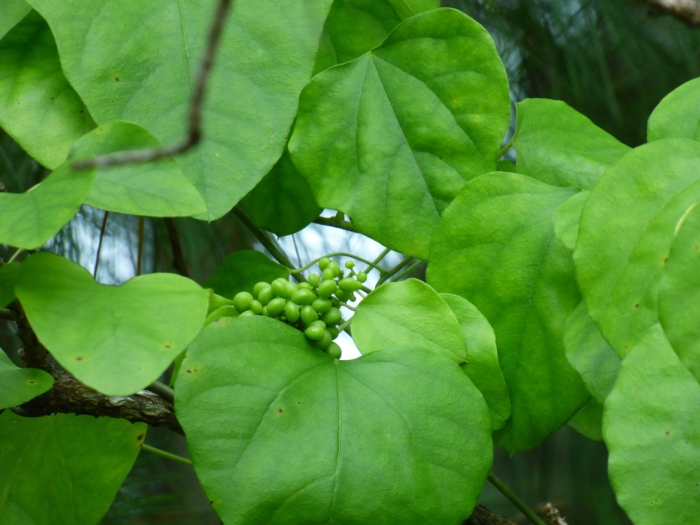Carolina Coralbead
(Cocculus carolinus)
Carolina Coralbead (Cocculus carolinus)
/
/

kcthetc1
Public Domain
Image By:
kcthetc1
Recorded By:
Copyright:
Public Domain
Copyright Notice:
Photo by: kcthetc1 | License Type: Public Domain | License URL: http://creativecommons.org/publicdomain/zero/1.0/ | Rights Holder: kcthetc1 | Publisher: iNaturalist | Date Created: 2021-08-03T14:01:14-07:00 |




















































Estimated Native Range
Summary
Cocculus carolinus, commonly known as Carolina Coralbead, is a deciduous perennial vine native to the understory of deciduous forests, forest edges, and stream banks in the Southern USA and Mexico. It can climb to heights of 5 meters or more, using other vegetation for support. The vine’s appearance is characterized by its twining habit and the presence of small, inconspicuous green flowers that are dioecious, meaning male and female flowers appear on separate plants. Flowering occurs in late spring, and by late summer, the plant produces an abundance of bright red drupes, which are particularly ornamental.
Carolina Coralbead is valued for its attractive red berries, which persist into winter and provide visual interest as well as food for birds. It is used in landscaping on trellises, fences, and as a naturalizing element in wild gardens. The plant is adaptable to full sun or part shade and requires medium water and well-drained soils for optimal growth. However, gardeners should be cautious as it can become invasive, spreading rapidly and proving difficult to remove once established. The seeds require a cold stratification period of three months and germinate within 21 to 30 days at 68 °F.CC BY-SA 4.0
Carolina Coralbead is valued for its attractive red berries, which persist into winter and provide visual interest as well as food for birds. It is used in landscaping on trellises, fences, and as a naturalizing element in wild gardens. The plant is adaptable to full sun or part shade and requires medium water and well-drained soils for optimal growth. However, gardeners should be cautious as it can become invasive, spreading rapidly and proving difficult to remove once established. The seeds require a cold stratification period of three months and germinate within 21 to 30 days at 68 °F.CC BY-SA 4.0
Plant Description
- Plant Type: Vine
- Height: 10-14 feet
- Width: 3-6 feet
- Growth Rate: Moderate
- Flower Color: N/A
- Flowering Season: Summer
- Leaf Retention: Deciduous
Growth Requirements
- Sun: Full Sun, Part Shade
- Water: Medium
- Drainage: Medium
Common Uses
Bird Garden, Butterfly Garden, Deer Resistant, Drought Tolerant, Low Maintenance, Salt Tolerant
Natural Habitat
native to the understory of deciduous forests, forest edges, and stream banks in the Southern USA and Mexico
Other Names
Common Names: Snailseed, Carolina Moonseed, Carolina Snailseed, Coralbead, Coralberry, Redberry Moonseed, Red-Berried Moonseed
Scientific Names: , Cocculus carolinus, Menispermum virginicum, Cebatha carolina, Menispermum carolinum, Menispermum carolinianum, Wendlandia populifolia, Androphylax scandens, Baumgartia scandens, Caesalpinia smilacea
GBIF Accepted Name: Cocculus carolinus (L.) DC.